"Green Float" - a community of 50,000 people who are self-sufficient in food and energy
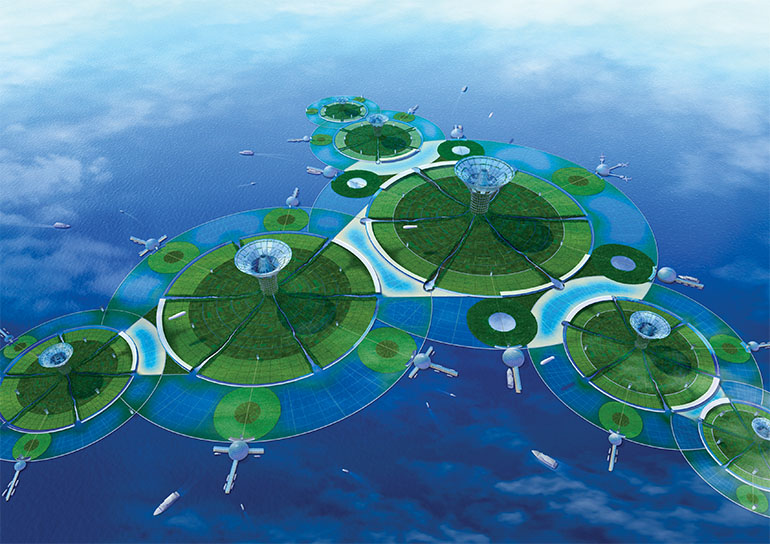
Credit: Shimizu Corporation
In the near future, Singapore may witness the construction of massive towers that can house thousands of people, rising above the water like a water lily leaf on a man-made island.
The idea was developed by the Shimizu Corporation, a major Japanese construction firm researching urban environments for a floating environment where people could actually live. The “Green Float” idea was initially created as part of an urban concept, first revealed in 2008, as the first phase of a future vision called the “Shimizu Dream”.
The concept consists of a 1,000-metre-high tower built on a 3,000-metre-diameter artificial island in the ocean, which will house as many as 50,000 people and include a plant factory for food self-sufficiency and a business zone for advanced research institutions. The waterfront area will be a natural farm and a facility for recycling waste materials.
Green Float is designed to simplify logistics and transportation, save energy by residing in high-rise buildings with cooler temperatures, and significantly lower CO2 emissions by utilising renewable energy sources like wind and solar power. Additionally, the design achieves carbon minus outcomes, where CO2 emissions are intended to stay below zero.
“The construction site is expected to be in an equatorial region that is less affected by typhoons and more self-sufficient due to the abundance of sunshine,” Ikuo Yoshida, Manager of Ocean Programs, Emerging Frontiers Division, emphasises. “Having a new habitat in the ocean, which covers 70 per cent of the earth’s surface, may lead to a solution to the problem of global population growth.”
What led to the project’s development in Singapore?
Mr Satoshi Inoue, Senior Manager of the Global Strategy Division, explains why this project was introduced in Singapore.
“When former Singapore Ambassador to Japan Lui Tuck Yew visited the Shimizu Institute of Technology in Japan in 2019, he expressed interest in Green Float, and we discussed the possibility of developing it in Singapore.”
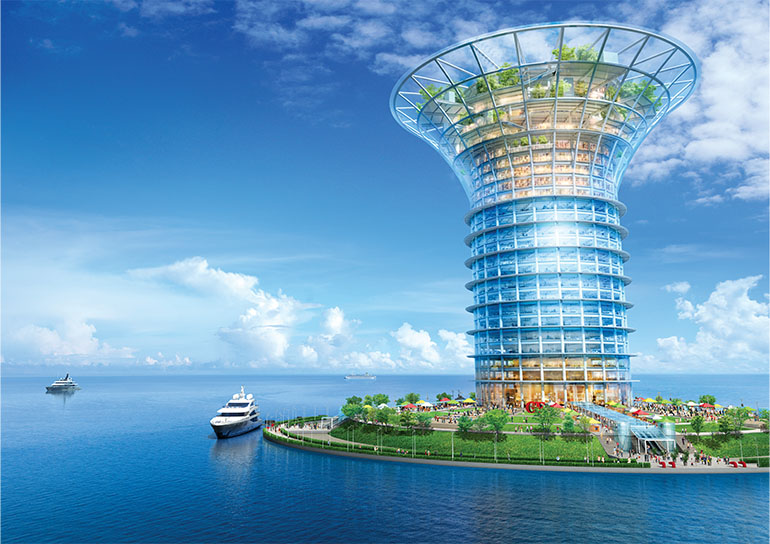
Credit: Shimizu Corporation
As context, in the 1980s, Shimizu Corporation was commissioned by the Housing Development Board (HDB), a government agency that provides public housing, to construct the largest high-rise apartments in Southeast Asia at the time.
“The government instituted a policy of taller buildings as a solution to Singapore's land shortage problem, which led to the development of the HDB,” Mr Inoue said. Since then, Shimizu has been involved in numerous projects in Singapore. The company has been working with the Building and Construction Authority (BCA) on quality control and design methods to increase productivity withour relying on skilled labour, which was a focus for the Singapore government. As a result of this relationship, former Singapore Ambassador to Japan Lui Tuck Yew made a visit to the Shimizu Institute of Technology.
Floating structures as an effective countermeasure to land shortage and sea level rise
The initial appeal of floating structures in Singapore can be attributed to two main factors.
First of all, Singapore has a land area of approximately 720 square kilometres, which is larger than the 23 wards of Tokyo. Singapore has expanded its land area by more than 20 per cent since 1960 through land reclamation, and it is estimated that an additional 56 square kilometres of land will be needed by 2030 to accommodate future population growth, as explained by Mr Shinji Kobayashi, General Manager of Ocean Programs, Emerging Frontiers.
“Landfilling in shallow areas was the standard approach but the cost increases the deeper the water goes. When the water depth reached more than 20 metres, we suggested building a floating structure for the Singaporean government.”
Credit: Shimizu Corporation
The second reason is that floating structures are an effective countermeasure against sea level rise due to climate change. As a low-lying island nation, Singapore is strongly affected by rising sea levels, including flooding. Aside from developing drainage systems, Prime Minister Lee Hsien Loong shared in an address that the Government would invest SGD 100 billion over the next 50 to 100 years to combat climate change and rising sea levels.
Floating structures are not affected by rising sea levels because they have a mooring system that allows them to float while maintaining their position on the sea surface. Another reason Singapore is paying attention to floating structures is that land reclamation destroys the natural environment of the sea, whereas floating structures do not,” said Mr Kobayashi.
Floating structure guidelines were developed in conjunction with the government.
Specifics regarding the floating structure, such as the start date of construction, the duration of the operation, and the scale of the project, have not yet been announced. However, the project is steadily moving forward with preparations.
“We have developed guidelines for floating structures with JTC Corporation, the government agency responsible for the operation and management of Singapore’s industrial and commercial districts, which Shimizu signed a memorandum of understanding (MOU) on the introduction of new technologies. We are also working with several agencies, introduced by the current Singapore Ambassador to Japan Peter Tan, such as the Urban Redevelopment Authority (URA) and the BCA to realise a floating structure," shared Mr Inoue.
20 July 2020 at Shimizu Corporation HQ (titles as of July 2020). From right to left: Masahiro Indo, Representative Director; Lee Chee How, Assistant Vice President, Healthcare, EDB; Kazayuki Inoue, President and Representative Director; Peter Tan, Singapore Ambassador to Japan; Toshiyuki Imaki, Executive Vice President and Representative Director; Satoshi Inoue, Deputy Director
Shimizu Corporation is also focusing on other environment-related projects, including the construction of Self Elevating Platform (SEP) vessels, used to construct clean energy and offshore wind power plants.
“We strongly feel that it is precisely because we live in an age of worsening environmental problems such as global warming and rising sea levels, that we are called upon to develop the Green Float that will help realise a ‘new affluence.’ It is our mission to promote development so that we can provide Green Float to countries facing environmental challenges at a lower cost.” explains Yoshida.
The Green Float II, which is about one-tenth the size of the first model, has already received AIP (Approval in Principle) certification from Nippon Kaiji Kyokai, a public third-party organisation related to marine floating bodies for safe implementation on the sea. This makes the construction of a floating structure in Singapore highly feasible, and Mr Kobayashi expresses his enthusiasm for the project.
“Now that we have the AIP, we would like to build it as soon as possible. We can suggest a variety of uses and sizes for other areas, such as small models and container terminals, even though the Green Float is primarily a concept for an equatorial city. Our plan is to construct a small structure first, with the intention of eventually realising a vaster Green Float in the future.”
This article was translated from its original Japanese version here. Some edits were made for readability.
